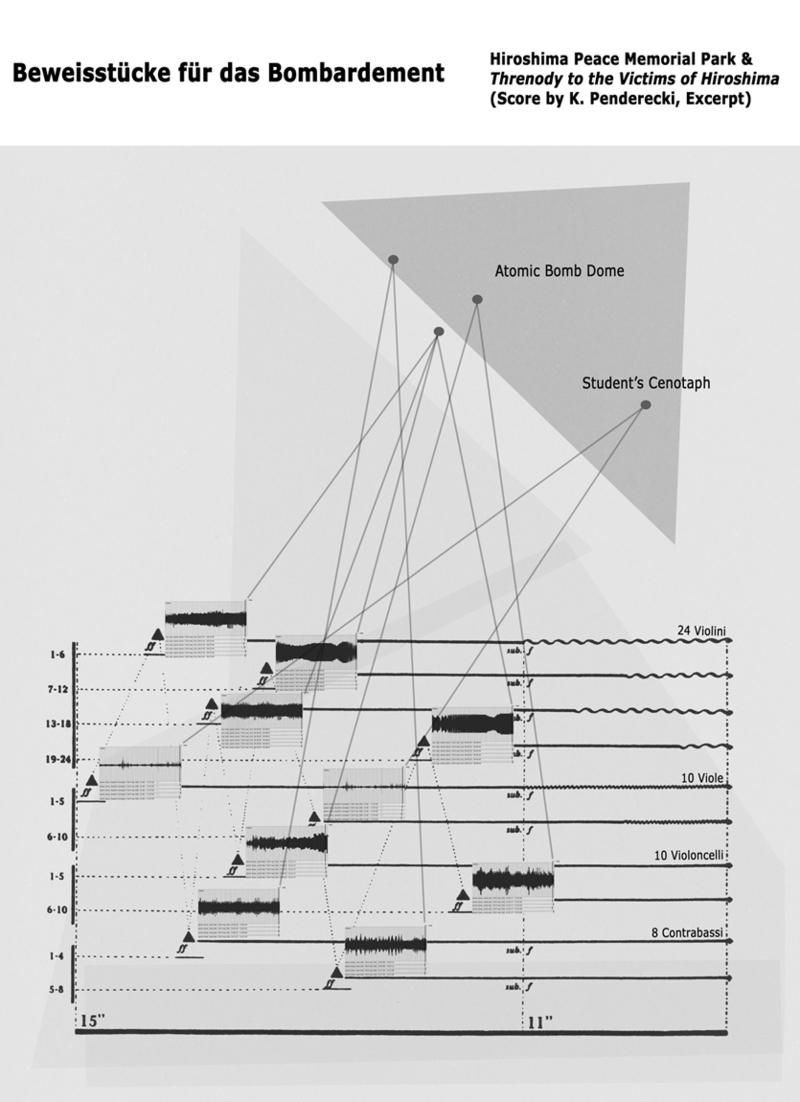Jan Jelinek:
Beweisstücke für das Bombardement
Jan Jelinek: Beweisstücke für das Bombardement (excerpt), 2015
Jan Jelinek:
Beweisstücke für das Bombardement
Produced for SWR. First broadcast: 7 July 2015. Length: 31:05 min. Conceived, composed and produced by Jan Jelinek. Beweisstücke für das Bombardement (Exhibits of the Bombardment) is a composition, a collage and a documentation. It was performed as a spatial sound diffusion for 47 loudspeakers at the ZKM Karlsruhe as part of ARD Hörspieltage 2015. In 2016 it was in the competition of the dokka documentary festival in Karlsruhe. A modified shorten version for MONOM speakers exists since 2022.
Seventy-one years after the atomic bomb was dropped, the catastrophe is still present: Designed by Kenzo Tange in 1954, Hiroshima Peace Memorial Park and the same-name museum are both a monument to the victims, a resource for tourism, and an ambitious memorial. Over several days, the author tried to capture the site acoustically. The result is a markedly subjective cartography. Views of the dome, the hysteria of school children in the park, documents of a devastated city in the museum: like a journal, the collage tours the site, station by station. The realization takes its cues from Kryztof Penderecki’s microtonal score Threnody for the Victims of Hiroshima.
On the realization
Following Penderecki’s score, the field recordings are organized in orchestral groups: instrument groups become terrain groups – the group of 24 violins, for example, becomes 24 recordings from the museum’s foyer; the group of ten violas becomes ten recordings from the first exhibition space – each instrument is represented by one field recording. By analogy with the piano keyboard, a time scale divides the field recordings into 88 units – allowing shifts in time to replace changes in tone. Recording location, time, and duration of playback are the key compositional criteria.
The resulting new interpretations are woven together with other collage fragments into a 30-minute audio composition. Beweisstücke für das Bombardement orients itself towards the orchestral organization of Threnody: the creation of sound mass - and the composition and modulation of textures with up to 52 sound layers. A harmonic approximation of the original was not planned as it would have led to the field recordings being too strongly distorted.

Audio Site Map (Hiroshima Peace Memorial Park / score excerpt Threnody for the Victims of Hiroshima), 2015
deutsch:
Das Radiostück Beweisstücke für das Bombardement wurde für den Südwestrundfunk produziert. Erstsendung: 7.7.2015. Das Hörstück hat eine Spieldauer von 31:05 Minuten. Komposition und Realisation: Jan Jelinek. Beweisstücke für das Bombardement wurde im Rahmen der ARD Hörspieltage 2015 als spatiales Klangdomkonzert für 47 Lautsprecher im ZKM Karlsruhe aufgeführt. 2016 war es im Wettbewerb des dokka Dokumentarfestivals in Karlsruhe.
Beweisstücke für das Bombardement ist Komposition, Collage und Dokumentation. Krzystof Pendereckis' Partitur Threnos – Den Opfern von Hiroshima liefert den kompositorischen Rahmen für Feldaufnahmen aus Hiroshimas Gedenkstätte.
Auch 70 Jahre nach dem Abwurf der Atombombe ist die einstige Katastrophe in Hiroshima präsent: Der von Kenzo Tange 1954 entworfene Hiroshima Peace Memorial Park und das gleichnamige Museum ist Opfergedenkstätte, Tourismus-Ressource und zugleich ambitioniertes Mahnmal. Über mehrere Tage hat der Autor versucht, das Gelände klanglich zu erfassen. Das Ergebnis ist eine betont subjektivistische Kartographie. Ansichten der Atombombenkuppel - Schulklassenhysterie im Friedenspark - in den Museumsräumen vor den Dokumenten einer verwüsteten Stadt: Tagebuchgleich schreitet die Collage die Stationen der Anlage ab.
Zur Realisation:
In Anlehnung an Pendereckis Partitur organisieren sich die Feldaufnahmen in orchestralen Gruppen: Instrumentengruppen werden zu Terraingruppen - die Gruppe der 24 Violinen zu 24 Aufnahmen aus dem Foyer des Museums, die Gruppe der zehn Bratschen zu zehn Aufnahmen aus dem ersten Ausstellungsraum - jedes Instrument wird durch eine Feldaufnahme repräsentiert. Analog zur Pianoklaviatur skaliert ein Zeitraster die Feldaufnahmen in 88 Einheiten - so können zeitliche Verschiebungen tonale Veränderungen ersetzen. Aufzeichnungsort, Zeitpunkt und Abspiel-/Loopdauer bilden die entscheidenden kompositorischen Kriterien.
Die neu gewonnenen Interpretationen verweben sich mit eigenen, freien Collagefragmenten zu einer 30-minütigen Audiokomposition. Beweisstücke für das Bombardement orientiert sich an Threnos’ orchestraler Organisation: Der Erzeugung von Tongemischen/ Sound Mass und der Komposition und Modulation von Texturen mit bis zu 52 Klangschichten. Eine harmonische Angleichung an das Original war nicht vorgesehen - hätte dies doch eine zu starke Verzerrung der Feldaufnahmen bedeutet.

Audio Site Map (Hiroshima Peace Memorial Park), 2015